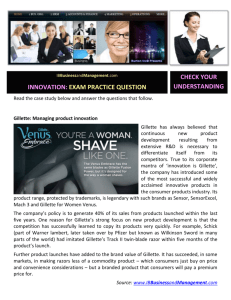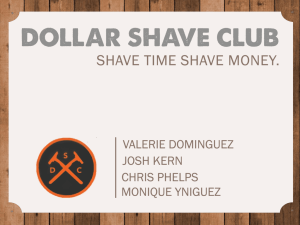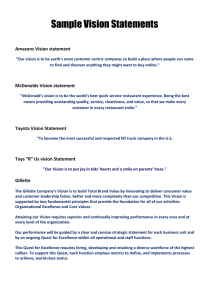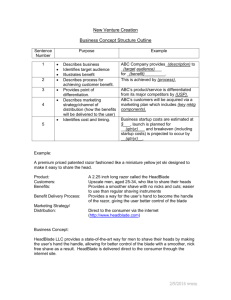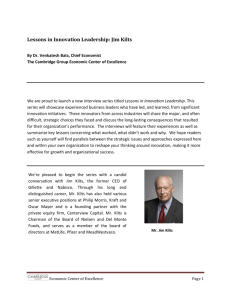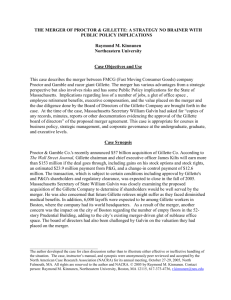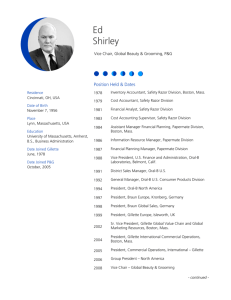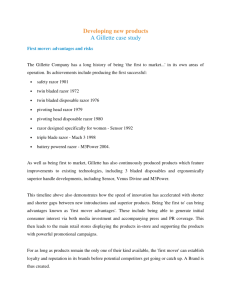Case Study - Gillette
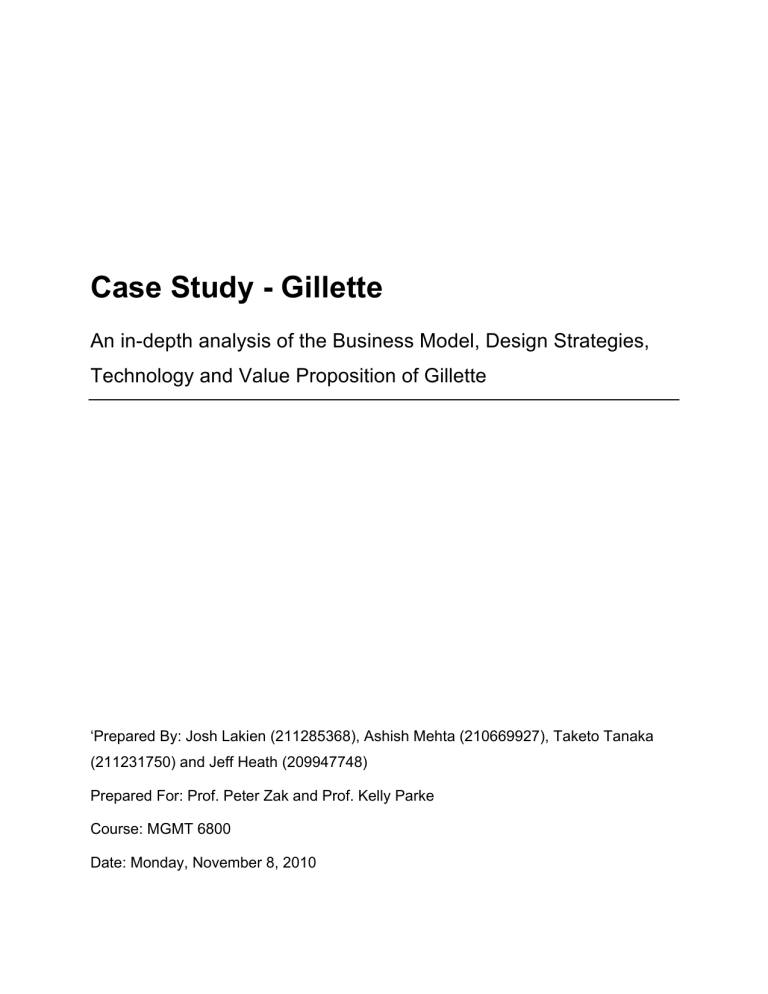
Case Study - Gillette
An in-depth analysis of the Business Model, Design Strategies,
Technology and Value Proposition of Gillette
‘Prepared By: Josh Lakien (211285368), Ashish Mehta (210669927), Taketo Tanaka
(211231750) and Jeff Heath (209947748)
Prepared For: Prof. Peter Zak and Prof. Kelly Parke
Course: MGMT 6800
Date: Monday, November 8, 2010
MGMT 6800 Case Study - Gillette Monday, November 8, 2010
Identifying the Opportunity - Shaving at the Turn of the 20 th Century
The face of shaving at the turn of the 20 th century was much different than what we know today. The straight razor was the most popular tool on the market for shaving.
The straight razor consists of a single, keenly sharp blade that folded in to a handle.
Conventional thought was that the ideal razor should last a lifetime if its blade was properly honed, and should be priced accordingly 1 . However, the straight razor did have significant drawbacks. First, maintenance of the blade was a painstaking chore that required constant stropping with a leather belt before each usage in order to maintain its keen edge. The blade would also require periodic professional sharpening when stropping would no longer achieve the required edge. Secondly, the straight razor was a very dangerous tool that required a significant amount of skill to use. They were commonly referred to as “cut-throat” razors, due to the fact that it was dangerous enough to cut a man’s throat. Due to the inconvenience and danger, men would commonly visit a barber for a shave or would only do so periodically at home 2 .
Frederick and Otto Kamp introduced the straight razor’s first major competition in 1880 in the form of the Star safety razor. It was a revolutionary design that introduced a hoetype razor with an edge shaped blade ( Appendix A ). It largely addressed the safety issue to the point where very little skill was required to achieve a thorough shave. As described by Oliver Wendell Holmes in Atlantic magazine, shaving with the Star razor
“could be performed with almost reckless boldness, as one cannot cut him, and in fact had become a pleasant amusement instead of an irksome task” 3 . It still did not address the key usability feature of having to repeatedly sharpen the blade. In fact, it made this
1 “Cutting Edge: Gillette’s Journey to Global Leadership”, Gordon McKibben, 1997.
2 http://homepage.ntlworld.com/paul.linnell/sso/razors.html
3 http://www.razorandbrush.com/perkam.html
!
2
MGMT 6800 Case Study - Gillette Monday, November 8, 2010 task even more cumbersome, as the user had to first remove the blade from the casing prior to sharpening, and then skillfully replace the blade afterwards.
The early 1900s were a time of extreme innovations. Technology was moving at a rapid pace. The automobile and household appliances had just become more affordable to the middle-class, the Wright Brothers had taken the first ever flight in an airplane, the motion picture industry had just launched and the vacuum cleaner was invented 4 .
Consumers were ripe for acceptance of brand new, revolutionary products. This is all foreshadowing what Gillette eventually took advantage of; acceptance of innovations coupled with the shift toward affordability to the masses. Marketing was also shifting from a product-centric orientation (focus on production, operations and efficiency) to a more consumer-centric orientation (what the customer really wants, benefits, values, etc.) 5 . Marketers were beginning to realize the high value in appealing to the emotional side of consumer minds. Consumers were being conditioned to accept brand new products that were marketed in brand new ways. Whether intentionally or unintentionally, King Camp Gillette (Gillette) took full advantage of these trends.
Gillette’s Inspiration : Gillette was a traveling salesman, and an aspiring entrepreneur.
Gillette worked for the Crown Cork & Seal Company, selling on-time-use bottle caps for standard beer and soft drink bottles. His employer and mentor had told him that the path to fortune was to invent a product that was not intended to be reused, but one that was disposed of after a single use, ensuring a steady stream of income from repeat purchases 6 . In 1895 Gillette had his inspiring vision of just such a product, as he was inspecting his dull razor blade. He envisioned an inexpensive double-edged razor blade
4 http://www.encyclopedia.com/doc/1G2-3468300168.html
!
5 http://en.wikipedia.org/wiki/History_of_marketing
!
6 http://www.classicshaving.com/articles/article/590351/5693.htm
!
3
MGMT 6800 Case Study - Gillette Monday, November 8, 2010 that was clamped to a handle that could be used until dull and then discarded. Gillette consulted various tools makers and scientists over the years to develop his product, but had been rebuffed at every turn suggesting that his idea was impractical. It was not until he met William Nickerson, a Massachusetts Institute of Technology-educated machinist, that he found someone willing to take on his project. Nickerson developed a production process to produce blades sufficiently thin and sharp, which could be made in mass quantities at relatively low cost. In 1903 the Gillette Safety Razor Company was born, and began selling the razor set at $5 along with disposable blades at $1 for a package of twenty 7 . The shaving industry was turned on its head.
Exploring the Opportunity - The Gillette Business Model
The Gillette business model is one of the key innovations in this story. By selling the handle and forcing consumers to repurchase Gillette blades once they wore out, he essentially solidified repeat sales and engrained customer loyalty.
The customer segment is quite broad, with the original Gillette safety razor targeting a single segment, the male population. After all, all men share a common need to shave.
Gillette would broaden its customer segment in the future to women with the introduction of the Venus razor blade in 2001 8 .
The core value offered by Gillette is the disposable blade offering overwhelming shaving convenience for every man. A disposable blade did not just diminish the necessity of polishing a blade, it made shaving simpler, safer, inexpensive, and a time saving exercise. Furthermore, it actually improved sanitation by changing the blade once it wore out. This convenient user experience encouraged a “Do It Yourself” mentality.
7 http://www.fundinguniverse.com/company-histories/The-Gillette-Company-Company-History.html
!
8 http://www.allbusiness.com/company-activities-management/product-management/5609471-1.html
!
4
MGMT 6800 Case Study - Gillette Monday, November 8, 2010
The initial distribution strategy was by mail order. Soon afterwards Gillette shifted it to a dealer network, in an effort to improve visibility of the product by word of mouth. Gillette would then move in to a retail distribution strategy.
Gillette is known for establishing the market strategy of ‘Loss Leader’. A memo from
Gillette says, "The greatest feature of the business is the almost endless chain of blade consumption, each razor paying tribute to the company as long as the user lives" 9 . This offers a stable revenue stream ; number of razors times blade consumption.
The key resource of Gillette is the disposable blade, not the razor itself. This core resource was secured by patents. As evidence, Gillette either sued or bought out competitors to prevent copying.
The key activities of Gillette were advertising and close inspection of the retailers.
Mainly through magazine advertisement, Gillette marketed his product to both customers and retailers.
The partner network most significant to Gillette’s success was the U.S. Government.
When Gillette was selected for the official razor for the U.S. army, 3.5 million razors and
32 million blades were provided during the World War 1 10 . This partnership enabled
Gillette to reach its entire target market, and was thus positioned as the dominant player
The most important cost of the Gillette business model was in solidifying customer relationships by using heavy advertisement. Gillette, told company directors in 1912
"The whole success of this business depends on advertising.
11 "
9 http://money.cnn.com/magazines/fsb/fsb_archive/2003/04/01/341005/
!
10 http://inventors.about.com/library/inventors/blrazor.htm
!
11 http://www.evancarmichael.com/Famous-Entrepreneurs/1907/King-Gillette-Quotes.html
!
5
MGMT 6800 Case Study - Gillette Monday, November 8, 2010
As has been described, Gillette launched the first razor of its kind. There were other types of razors, however they did not have all of the benefits of a Gillette razor. Once the idea about the Gillette razor got out, competition heated up quickly. First, because every single man on the planet is a potential customers and second, because making modifications were easy (which is why Gillette patented the razor) 12 .
Conceptualizing the Opportunity – User-Centric
Words by King C. Gillette, “As I stood there with my razor in hand, my eyes resting lightly as a bird setting down on its nest, the Gillette razor was born. I saw it all in a moment !
I could see the way the blade could be held in a holder; then came the idea of sharpening the two opposite edges on the thin piece of steel that was uniform in thickness throughout.” 13
This is how the first Gillette safety razor, also known as the “Double Edged Razor” was born. The older safety razors used a single-piece razor and needed constant maintenance. Gillette saw an opportunity and came with the solution in the form of the double edged razor.
The double edged razor had a cap with a threaded stem and two studs that aligned with the three holes in the blade. The threaded stem on the cap engaged in the inner handle.
Rotating the end of the handle clamped the guard, the blade, and the cap together in a neat sandwich ( Appendix B ). The whole setup made sure that the disposable blade was positioned firmly, just as a permanent blade would be. Since the blades were disposable, it met the user need of getting away without the time consuming sharpening
12 http://web.mit.edu/invent/iow/gillette.html
!
13 http://www.enchanteonline.com/pages/faqs/WhatIsMethodShaving.pdf
6
MGMT 6800 Case Study - Gillette Monday, November 8, 2010 process. This made the product more engaging and reliable to the consumers. It is this product which made the self shaving phenomenon famous.
The key to the Gillette concept is the creation of the “Loss Leader” model of giving away a product (the razor) in place of the high margin replacement blades. Gillette used this as an opportunity and hence its mainstream product line of safety razors came into existence 14 . This is a classic case to showcase how design played important role in transforming an entire industry, which was previously not design oriented. As technology had advanced at such a rapid pace throughout the 20 th century, in order to see how crucial design is to Gillette, an analysis of their more design-heavy ad innovative razors ever, the Mach 3, is discussed below. This case will illustrate the immense pressure put on design in order to launch a product.
Product Innovation and Opportunity: Sometime before April 1998 Gillette had faced slow growth in its razor division. The entrance of many smaller players, such as Schick, made the market look fragmented. Investors had begun to fret about slowing growth and lackluster growth as Gillette. This led the Gillette to look out for opportunities in razor industry. There was an opportunity in the razor industry to work on reducing shaving time and increasing safety. Gillette had found a way to bond diamond hard carbon to silvers of steel 15 .
The Product Concept, Prototype and Design Strategy : The product had completely new feature additions compared to its older product, the Gillette Sensor . Mach 3 offered 3 blades in place of 2. Kevin Powell, the lab director at Gillette research describes, “Just adding blades doesn’t guarantee a smoother shave”. In fact, more blades could also
14 http://www.classicshaving.com/articles/article/590351/5693.htm
15 ibid
!
7
MGMT 6800 Case Study - Gillette Monday, November 8, 2010 result in more irritation. However there is a science in the number of blades to be added. There are 2 important design concepts, one is the distance between the blades and other is the number of blades.
As per Anne Stewart, the center’s Science Director, the distance between the blades follows a phenomenon known as hysteresis. When a razor blade encounters a hair, it does not only cut through it, it also pulls it a little way out of its follicle. If there is another blade following close behind, it will slice into the hair lower than the shaft, before it has time to retract into the follicle, and shave below the skin level. Care also has to be taken to optimize the distance between the blades such that the second blades allow the hair to be pulled sufficiently from its follicle and also it doesn’t get the same hair at the same time of the first blade 16 .
Mach 3 was prototyped with a superior design process that breaks the razor distinctly into its 2 main components, head and the razor stem ( Appendix C ). Gillette uses a highly sophisticated manufacturing technology while implementing an innovative carbon steel moulding technology for the production of the stem. The end result is a highly ergonomic and accurately controlled razor.
The format of the razor was drastically changed with the introduction of the removable head. Kinesthetically, the handle consists of a rubber grip, the main cost component meant to create a solid attachment to the hand while shaving, a joint between head and handle, and the type (vertical naming - branding). The head is the main business driver for Mach 3 and is the focal point of the razor. The head is designed in such a way that the blades are mounted on springs and the movement of the head is free which adjusts to the face. It also ensures that the user is always looking at the blade in the mirror to
16 Thomas Jones, “Cutting Edge”, The Guardian, Saturday, 4-10-2008
8
MGMT 6800 Case Study - Gillette Monday, November 8, 2010 ensure they are shaving in the right place. The angle of the blades on the face changes based on the pressure applied through the stem. In other words the user can control the angle with making it easier to shave. The blades are positioned in such a way that with a splash of water the residual of hairs can be cleared. Proportionately, the razor is able to fit in all hand sizes and the blades are large enough to be effective but small so they do not pose a major safety risk. The head also has a lubricating strip that moisturizes the skin while shaving and makes the shaving experience less irritable.
The Mach 3 has almost 35 patents including the manufacturing technology and design of cartridge, which is the head part of the razor 17 . This mitigates design infringement cases and results in a highly profitable blade cartridge business.
The User Experience: Effective : Measured in closeness of shave, the Mach 3 experience has been very effective to users. They were able to get a better and closer shave compared to other products. Shaving results in a smooth face, rarely leaving any residual hairs. Efficient : Measured with the number of shaves. The Mach 3 has been able to deliver a close shaving with fewer strokes so one can use a blade for longer.
William J. Flynn, Business Director for blades and razors at Gillette, “Most men take an average of 100 to 500 strokes per shave, often going to same area again and again.
Mach 3 gives closer shave with fewer strokes” 18 . Engaging : With a superior aesthetic design, a solid and lightweight handle and a face shaping detachable head, a Mach 3 shave is an engaging experience. The user is involved in the easy maintenance of the razor and essentially controls the entire shaving process, through pressure and direction Error Tolerant : The Mach 3 is designed to be error tolerant. The lubricating
17 http://www.giipinfo.com/significance_of_patents.aspx
!
18 http://www.strategy-business.com/article/16651?gko=927cc
!
9
MGMT 6800 Case Study - Gillette Monday, November 8, 2010 strip prevents cutting the skin when shaving around corners. There is a plastic cover to put on the blade when not being used and the rubber grip prevents the razor from slipping out of the hand while shaving. Easy to Learn : The flexible head, which sits flatly on any man’s face, makes the Mach 3 very easy to learn and use. One can use previous shaving experience to pick up a Mach 3 and use it right away as it follows the accepted shaving style and procedures.
Value Proposition
Due to the nature in which the innovative Gillette razor was founded, the value proposition was a key to success from the beginning. As the company and brand grew in popularity, it also grew internationally, so a clear, concise and consistent value proposition has been required and has been the backbone of the company for over 100 years. While new razor models, like the Mach 3, are continuing to be launched on a yearly (and sometimes monthly) basis, the essence of the value proposition for each razor has been greatly consistent. This is true because of the consistent goals of target consumers - all men grow facial hair and most men shave and want to avoid injury. A great way to analyze the value proposition of Gillette’s razors is to look at the proposition for their first products and look at their most successful product ever, the
Mach 3. The value statement for the Mach 3, which took the company two years to write, is “"the closest shave ever in fewer strokes - with less irritation." 19
This can be contrasted to the situation King Gillette found himself in in 1903 while shaving (mentioned in the first section of the paper. A dull razor would be dangerous, for travelling salesmen in trains that move back and forth 20 . Therefore, the value
19 http://www.strategy-business.com/article/16651?gko=927cc
!
20 http://www.school-for-champions.com/biographies/gillette.htm
!
10
MGMT 6800 Case Study - Gillette Monday, November 8, 2010 proposition of the first Gillette razor was “shave safely while on the go with an always sharp blade.” While this proposition has evolved over the years, the core theme is consistent – “the safest and closest shave”.
Product Launch: King Gillette had to redefine the product launch efforts in order to communicate the new product and ordering process. Gillette was very against advertising so the new safety razor was launched using magazine ads stating, “We offer a new razor.” ( Appendix D ). However, this quickly turned into a full-scale advertising campaign, investing $0.50/razor (twice that invest a year earlier when sales were only
51 razors and 168 blades in the first year). Ads were benefit and comparative focused.
Gillette was the first company to use testimonials from sports figures (like Baseball Hall of Famer Honus Wagner) to help promote the product. Initial distribution was through mail order but in order to keep up with demand, distribution was quickly changed to a retail partner model (whom Gillette kept a close eye on in order to prevent discounting the high price point of $5) 21 .
Procter & Gamble have only added to the size and scope of the marketing campaigns for Gillette. However, launching a new razor in today’s complex and dynamic markets is just as much about mass advertising and trial as it was 100 years ago. P&G has stayed true to the original Gillette marketing strategy, however enhancing with the times.
Recent product launch campaigns include giving away the razor for free in the mail 22 ,
21 http://money.cnn.com/magazines/fsb/fsb_archive/2003/04/01/341005/
!
22 http://itotd.com/articles/295/giving-away-the-razor-selling-the-blades/
!
11
MGMT 6800 Case Study - Gillette Monday, November 8, 2010 coupons in the newspaper 23 , television ads stressing the technology and design of the products 24 and celebrity endorsements with David Bekham 25 .
Market Feedback: Gillette received very positive market feedback from men, which went 100% against all of the experts who were approached during product exploration 26 . The market reacted very positively because of the novelty and simplicity of the design. It was the first time that razor blades were sold in multi packages and razor heads had more than one blade 27
Key Technology : In order to launch such an innovative and successful product, technology played a critical role. The technology required to create the Gillette razor did not exist at the time so King worked with engineers at the Massachusetts Institute of
Technology’s to perfect the elements of the safety razor 28 . He also worked with his partner, William Nickerson, in order to advance Metallurgical processes in order to produce cheaper and better blades 29 . In order to protect all of this revolutionary technology, Gillette patented his blade design in 1904 ( Appendix E ) 30 .
23 http://hubpages.com/hub/Gillette-Razors-A-brand-review
!
24 ibid
!
25 http://www.docstoc.com/docs/14822638/Gillette-launches-the-M3Power-shaving-system
!
26 http://money.cnn.com/magazines/fsb/fsb_archive/2003/04/01/341005/
27 http://web.mit.edu/invent/iow/gillette.html
!
!
28 http://www.articlesbase.com/entrepreneurship-articles/the-invention-of-the-safety-razor-accidentally-created-a-novel-businessmodel-1172006.html
!
29 http://health.howstuffworks.com/wellness/beauty-hygiene/shaving.htm/printable
30 http://inventors.about.com/library/inventors/blrazor.htm
!
!
12
MGMT 6800 Case Study - Gillette Monday, November 8, 2010
Innovative Lessons Learned
The innovation in both the product and business model of Gillette has provided many innovation lessons to be learned:
Introduce a New Business Model: Confidence in a new business model can bring great rewards. Gillette expanded on the simple concept of selling single-use products to ensure repeated purchases, and developed the ‘loss-leader’ model. The Gillette model has been successfully copied by countless other industries such as video games and computer printers.
Opportunities Surprise: Have an inquisitive mind as the next idea can come at any time.
Gillette was determined to discover an idea for an innovation that would make him successful. After years of disciplined reflection, the idea for the Gillette safety razor came to him in a flash of inspiration while shaving.
Push Manufacturing Boundaries: An idea might require manufacturing technology that does not exist yet. This should not act as a barrier to pursuing a potential innovation; rather it should only further motivate exploration and research.
Customer Retention: It is important to develop a product that will keep customers coming back to buy more. Gillette understood that the key to repeat purchases was in providing a product that a customer wanted and needed to buy over and over. The disposable razor head gave Gillette the perfect platform to generate an ongoing revenue stream.
Understand Strengths and Resources: One must be able to leverage their capabilities and know where to go to make up for shortfalls. Gillette understood that he had a great
13
MGMT 6800 Case Study - Gillette Monday, November 8, 2010 idea, but also understood he needed to make partnerships and relationships with those with technical expertise to make his dream become a reality.
Use the Experts: Talking with scientists, designers, business people, or even consumers about a product concept can provide great insight. Gillette’s former employer and mentor planted the seed of finding a product that required repeat purchases. This helped him form the idea that would lead to his eventual breakthrough.
Pretend it’s Magic: Dream big and develop solutions that make the biggest change.
When Gillette was trying to get his idea off the ground he was constantly told that it was impossible, that you could never make a blade thin enough for a cost effective price.
Gillette persevered and brought his impossible dream to reality.
User-Centric Design: Make sure that there is a targeted user when designing a product.
In the case of Gillette, it helps when the inventor is a user as well. After all, it is often the user themselves that have the best idea of how to identify and solve their everyday problems. In many cases, it is also the user that is most motivated to resolve these issues in to innovative solutions.
Observe Reflect and Act: Dr. Otto Charmer, MIT Faculty, introduced the concept of
“leading from the future.” In line with this concept, Gillette has followed the Observe,
Reflect and Act model. Gillette reflected, found a need for change (reduced the time to shave), which helped to find its first innovative product line, the safety razor.
14
MGMT 6800 Case Study - Gillette Monday, November 8, 2010
Appendix A – Originally Filed Star Straight Razor Patent – 1880 http://www.razorandbrush.com/perkam.html
15
MGMT 6800 Case Study - Gillette
Appendix B – Picture of the Gillette Double Edged Razor
Monday, November 8, 2010
16
MGMT 6800 Case Study - Gillette
Appendix C – Components of the Mach 3 Razor
Monday, November 8, 2010 http://www.slideshare.net/leo/mach3
17
MGMT 6800 Case Study - Gillette
Appendix D – Original 1904 Gillette Magazine Ad
Monday, November 8, 2010 http://cgi.ebay.com/ws/eBayISAPI.dll?VISuperSize&item
=310265130268
18
MGMT 6800 Case Study - Gillette Monday, November 8, 2010
Appendix E – Originally Filed Safety Razor Patent - 1904
!
http://www.google.com/patents?id=DhFMAAAAEBAJ&pg=PA1&source=gbs_selected_pages&cad=1#v=onepage&q&f=false
19
